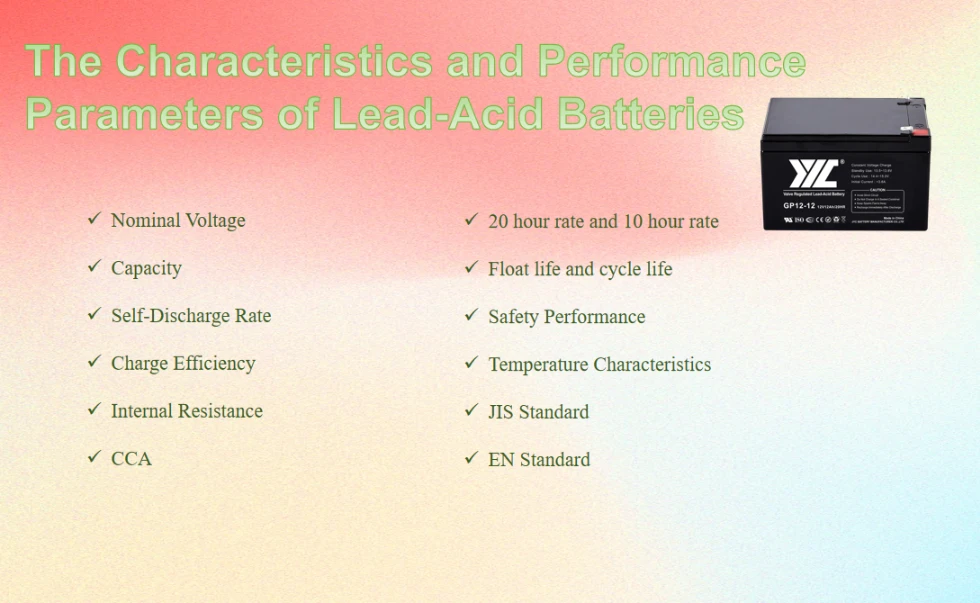
Lead–acid batteries have been in existence for decades as reliable energy storage options in several applications, from powering automobiles to backup power sources. Their inherent characteristics and performance parameters make them a fixture in the world of batteries which is sure to continue being so. In this article, we shall explore some essential aspects which define lead–acid batteries illuminating their intricacies and applications.
Introduction
As far as energy storage is concerned, lead-acid batteries have retained relevance even as newer technologies like lithium-ion and solid-state hog the limelight. Their strength, cost-effectiveness, and ease of adaptation ensure they remain in many industries. A bit of understanding about some key characteristics and performance parameters of lead-acid batteries will help both experts and laypeople make informed decisions about their use.
1. Nominal Voltage
The nominal voltage of a battery refers to the standard output voltage delivered by the batteries while generating power. The standard lead-acid batteries are 2 volts per cell, with common configurations ranging from 6 – 12 cells. This makes 12V batteries one of the most common batteries used in automobiles and other applications. Nominal voltages are important for ensuring compatibility with the devices they power.
Understanding the nominal voltage is essential for determining the state of charge, estimating its remaining capacity, and ensuring proper operation within various applications. While this standardized value guides design considerations, it becomes crucial to consider actual voltage behavior during real-world usage with respect to batteries.
2. Capacity
Capacity is a significant metric that describes the amount of energy a battery can store and deliver. Expressed in ampere-hours (Ah), it shows what kind of battery endurance it is. Lead-acid batteries are able to exhibit different capacities depending on factors like size, configuration, and design. This parameter affects how long a battery can sustain a load before recharging.
Lead-acid batteries have a capacity that varies depending on discharge rate as well as temperature. Their capacity generally decreases with slow discharges while increasing with high rates. Moreover, lead-acid batteries suffer reduced capacity at extreme temperatures, especially during cold conditions.
3. Self-Discharge Rate
The self-discharge rate of lead-acid batteries refers to the loss of stored energy in this battery over time despite being unused or not connected to a load. This happens due to chemical reactions occurring within the cells of this battery cell structure. The internal characteristics of lead-acid batteries exhibit a relatively higher self-discharge rate compared with some other battery chemistries.
For instance, the self-discharge rate of lead–acid batteries is affected by factors such as temperature and battery age. High temperatures accelerate the self-discharge process. As a result, they are decreasing battery performance and reducing its lifespan. In order to offset this issue, new lead–acid battery designs, as well as technologies, have incorporated better materials with improved construction methods.
4. Charge Efficiency
Charge efficiency is one of the most critical performance parameters that indicates how effectively a battery can convert electrical energy during charging. Lead acid batteries have reasonably good charge efficiency. Modern designs achieve around 85-95%. The amount of time and effort required to recharge the battery indicates this efficiency. This emphasizes the significance of repetitive charging as a component of applications.
Lead-acid battery charge efficiency gets affected by many factors, including voltage, current, and charging temperature. Overcharging leads to a reduction of charge efficiency as more loss of energy happens heat and gases are generated within the battery. High discharge rates reduce charge efficiency because it creates more excellent internal resistance as well as inefficient transfer of energies therein.
5. Internal Resistance
Internal resistance adds even further to the power efficiency of a battery. Uneven energy loss may occur during discharge and charging due to increased intern resistances, which generate heat. The moderate intern resistances characterize lead acid batteries, consequently affecting their performances on high current demands, which are caused by factors such aspects such as electrolyte/ electrode material resistances, among others. This resistance leads to voltage drops within the battery that happen both during charging processes as well as discharging ones.
High internal resistance has many implications. During discharge, the output voltage of the battery is affected by a high internal resistance that affects devices or systems relying on its battery performance. Also, during high current flows, heat is generated heat due to these kinds of internal resistance; thus, energy losses are also incurred, as well as the acceleration of battery degradation battery.
6. Cold Cranking Amps (CCA)
One of the most critical parameters of performance in lead-acid batteries, especially those for automobile purposes, is Cold Cranking Amps (CCA). CCA represents a measure toward showing how much current can be delivered at low temperatures and indicates how long one can maintain this current without keeping any acceptable minimum voltage level.
The first power of a battery illustrates well how one pretty good battery could crank an engine under cold conditions. Batteries with higher CCA ratings have more electrical current to the starter motor and thus enable reliable ignition of the engine even when facing demanding weather challenges like increased engine oil viscosity.
7. 20-Hour Rate and 10-Hour Rate
The 20-hour rate and the 10-hour rate are used in measuring lead–acid battery capacity over different periods.
“C20” is the discharge rate of a lead acid battery for 20 hours. This rate refers to the amount of capacity or energy it has to deliver some steadier current for 20 hours while keeping its given voltage. This is mainly available in determining the capacity of deep cycle lead acid batteries whose applications demand sustained lower currents over a long period.
Equally, the 10-hour rate, denoted as “C10,” measures battery capacity over a discharge period of 10 hours. Such kind of rate is mainly applied in smaller lead–acid batteries. It can indicate how effective or inefficient the battery performs when used in applications requiring higher discharge rates compared to the 20-hour rate.
Such rates standardize the measuring and reporting of battery capacities so that consumers, as well as manufacturers, can make informed choices concerning battery choice keeping in mind their requirements. Besides, though some batteries are able to tolerate higher discharges at faster rates though, this will affect their capacity as it varies with factors like internal resistance and chemical processes within the battery.
8. Float Life And Cycle Life
Float and cycle life are key indicators of lead acid durability, reflecting its performance and longevity under different operating conditions.
Float Life: Float life is when a lead acid battery can reliably operate in a float charging state with little or no noticeable deterioration. In float charging, the battery retains its connection to a continuous trickle charge at a lower voltage but continues to have a state of charge. Float life is needed for applications requiring an assured and steady power source, such as standby backup systems and emergency lighting. More significant float life shows how long the batteries will tolerate prolonged periods of standby operation while maintaining their capacity and performance.
Cycle Life: Cycle life is the number of charge-discharge cycles a lead–acid battery can withstand without capacity deteriorating markedly. This parameter is useful in applications requiring frequent cycling, such as renewable energy storage and electric vehicles. Higher cycle life displays tolerance to repeated charge and discharge cycles while maintaining the capacity and performance of a battery. Discharges more profound than what is recommended will affect cycle life.
The knowledge of both float life and cycle life helps the users choose lead-acid batteries matching their specific application requirements. Balancing float life, as well as cycle life, is significant for optimizing the battery’s operational lifespan and efficiency under various scenarios.
9. Safety Performance
Safety is a significant component of performance in lead acid batteries compared with other less prone different battery chemistries in thermal runaway, still lead-acid batteries present safety considerations:
1. Gassing and Ventilation: During charging, the lead-acid batteries produce hydrogen and oxygen. Under poorly ventilated or confined spaces, these gases accumulate, which poses an explosion risk element on it. It would be best to use adequate ventilation to dissipate such gas without posing an explosion risk element.
2. Acid Leakage: Lead-acid batteries have sulfuric acid as the electrolyte, so leakage may result from any damage caused to the battery casing. This also causes chemical burn risks together with possible environmental hazards.
3. Overcharging: In the action of overcharging, there is more gas production, leading to electrolyte loss, overheating, and possibly damaging the battery. Accidental short circuits due to damage or internal faults lead to heat generation, electrolyte spattering, and potential fires.
4. Maintenance: Battery failure may result from improper handling, which includes adding non-distilled water or incorrect charging methods, gas release or acid leakage.
Proper handling, maintenance, and storage techniques, as well as following manufacturer guidelines, can reduce safety concerns related to lead-acid batteries.
10. Temperature Characteristics
Temperature characteristics affect the performances of lead-acid batteries to a large extent. At different temperatures, these batteries exhibit varied behaviors: Charging and Discharging Efficiency: Cold weather acts as an obstacle for chemical reactions within the battery in a short time. These reduced chemical reactions cause poor charging along with discharging efficiency for the battery. Elevated temperatures may accelerate these reactions to speed up capacity loss.
●Self-Discharge: Under extreme environmental conditions, high temperatures may accelerate the self-discharge rate of a battery, causing it to lose energy faster when idle. This is especially relevant in applications that involve long periods of battery storage.
●Electrolyte: Extreme temperatures may affect the viscosity of electrolytes and reduce ion flow, reducing overall battery performance.
●Lifecycle: Operating lead-acid batteries at extremes of temperature, especially high temperatures, will accelerate aging processes and reduce the battery’s operational life.
Proper temperature management, such as insulation or ventilation during cold storage or hot operation, would ensure optimum lead acid battery performance and prolong its operational life.
11. JIS Standard
The Japanese Industrial Standard (JIS) for lead-acid batteries, mainly JIS D5301, defines requirements and specifications for automotive batteries usually seen in vehicles. The standard covers various aspects, including dimensions, performance characteristics, labeling, and testing methods.
JIS D5301 defines parameters like capacity, cold cranking performance, reserve capacity, and internal resistance. It also lists labeling requirements to give consumers information on the capabilities of a battery.
This standard is harmonious as it keeps quality in automotive batteries produced and sold within Japan so that consumers can make informed choices and ensure compatibility with their vehicles. These guidelines are followed by manufacturers who create batteries attaining the stipulated performance and safety criteria. Adherence to the JIS standard improves battery reliability, supports industry regulations, and contributes to the smooth functioning of vehicles by offering standardized batteries with consistent performances throughout.
12. EN Standard
The EN (European Norm) specifies the use of lead-acid batteries in automobile starters. It has some design parameters, performance, safety as well as labeling of a battery.
Entitled EN 50342, this describes such parameters as capacity, cold cranking performance, reserve capacity as well as terminal dimensions. It also lists testing methods to asses these so that they are consistent and accurate across various brands of batteries.
The standard tries to ensure that starter batteries’ quality, safety, and reliability in this market have been achieved. Compliance with EN 50342 allows producers to manufacture batteries meeting established performance and safety criteria, thereby increasing consumer confidence as well as maintaining compatibility with vehicles. Compliance with the EN standard supports regulatory requirements and enhances vehicle-operating efficiencies by providing standardized batteries bearing consistent performance attributes.
The Bottom Line
Lead-acid batteries remain relevant due to their distinctive characteristics and performance parameters. From the nominal voltage and capacity to their safety performance, as well as temperature characteristics, these have proved the reliability of their usefulness as well as versatility. Whether used in vehicles, backup power systems, or any other application, understanding such parameters is integral for maximizing effectiveness and longevity. As technology progresses, lead acid batteries will most probably keep evolving, keeping themselves intact in the world of energy storage.



